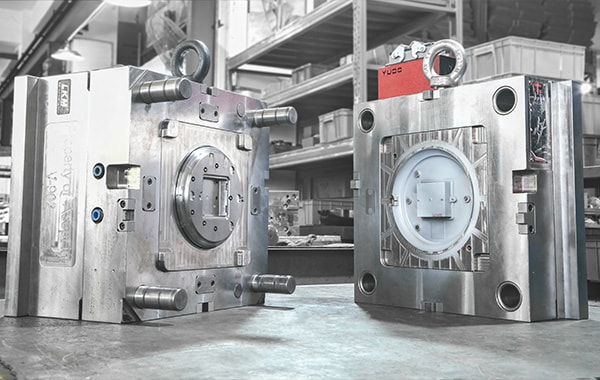1. Evolution of Injection Mold Technology
Injection mold manufacturing is a core pillar of modern manufacturing, especially in industries such as automotive, electronics, medical devices, and home appliances.
In the early days, mold making relied heavily on manual skills and hands-on experience. Design drawings were usually hand-sketched by engineers, and machining was performed using traditional lathes, milling machines, and planers. This limited both efficiency and precision.
By the late 20th century, the widespread adoption of CAD/CAE/CAM digital technologies revolutionized the industry. Designers could perform 3D modeling, flow analysis, and cooling analysis in a virtual environment, significantly reducing trial runs and rework.
Meanwhile, advanced machining technologies such as CNC machining centers, Electrical Discharge Machining (EDM), and wire cutting increased mold precision to ±0.01 mm or even higher.
In recent years, smart manufacturing and the Industrial Internet of Things (IoT) have further accelerated industry upgrades. By integrating IoT sensors, manufacturers can monitor mold temperature, pressure, and operating cycles in real time, enabling predictive maintenance and full life-cycle management.
2. Mold Structure, Cooling, and Ejection Mechanisms
A high-performance, durable injection mold must be carefully designed with several key factors in mind:
Parting Line and Opening Direction
The parting line determines how the mold opens and the final product’s dimensional accuracy. It should be positioned to avoid passing through critical aesthetic surfaces or structural areas.
Draft Angle
A reasonable draft angle (typically 1°–3°) minimizes friction during ejection, preventing deformation or surface scratches. For deep cavities or high-gloss parts, the draft angle must be precisely calculated.
Cooling System
Cooling efficiency directly affects cycle time. Cooling channels must be designed to cover the cavity uniformly to prevent warpage or sink marks. The recent adoption of 3D-printed conformal cooling channels has significantly improved cooling uniformity.
Ejection Mechanisms
Common systems include ejector pins, stripper plates, and air ejectors. For side holes or undercuts, sliders or lifters are required for core pulling.
3. Rapid Prototyping and High-Speed Machining
As market demand pushes for faster product launches, mold manufacturing must balance speed, precision, and cost.
Rapid Prototyping
Technologies like SLA (Stereolithography) and SLS (Selective Laser Sintering) can produce mold prototypes within days for functional verification or small-batch production.
Metal 3D Printing shows great potential for creating complex cooling channels or unconventional mold geometries.
High-Speed Cutting (HSC)
High-speed machining centers operating at high spindle speeds and feed rates can directly cut hardened steel molds (HRC50+), eliminating secondary machining after heat treatment while achieving superior surface finish and shorter lead times.
4. Hot Runner Systems and Modern Foaming Technologies
Hot Runner Systems
Unlike conventional cold runners, hot runner systems keep molten plastic flowing without solidifying inside the channels. This reduces runner waste, saves material, and shortens cycle times. For multi-cavity molds, hot runners also ensure balanced filling for consistent part quality.
Gas-Assisted Injection Molding (GAIM) & Chemical Foaming
- GAIM injects high-pressure nitrogen gas to form hollow sections, reducing material consumption while improving structural rigidity.
- Chemical foaming uses blowing agents that decompose to release gas, lowering product density and improving insulation—ideal for lightweight home appliance housings and automotive interiors.
5. IoT, Data-Driven Manufacturing, and Industry Applications
Data-Driven Life-Cycle Management
Integrating sensors for temperature, pressure, and vibration allows real-time data collection. Cloud-based analytics can predict mold lifespan, schedule maintenance in advance, and prevent costly downtime.
Application Cases
- Automotive: Large bumper molds using hot runner + GAIM for lightweight, high-quality surfaces.
- Electronics: Precision connector molds leveraging high-speed cutting + micro-injection to achieve ±0.005 mm tolerance.
- Medical: High-cleanliness molds producing disposable medical consumables with fully automated lines.
6. New Materials, Green Manufacturing, and Global Competition
New Material Applications
High-thermal-conductivity mold steels (e.g., copper-alloy inserts) can greatly improve cooling efficiency. Composite mold materials reduce weight while maintaining strength.
Green Manufacturing
Recycling plastics, lowering energy consumption, and reducing waste are becoming mandatory requirements for international clients.
Global Competition and Collaboration
Emerging manufacturing hubs in Southeast Asia are rising. Chinese mold manufacturers must embrace technology upgrades and differentiated services to stay competitive.
Author’s Note
Injection mold manufacturing is a multidisciplinary field that combines design expertise, machining technology, and materials science. Whether you’re a new engineer or a seasoned toolmaker, continuous learning, adopting smart manufacturing, and optimizing processes are key to staying ahead in an increasingly competitive global market.



